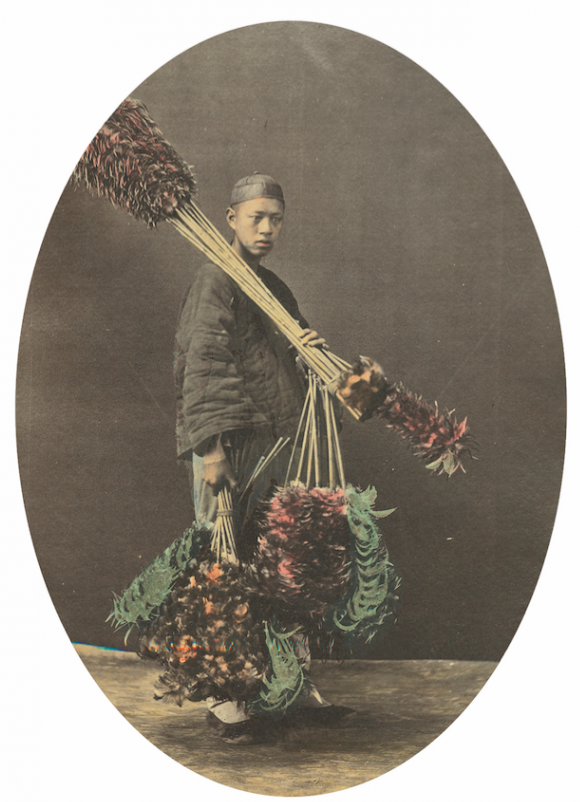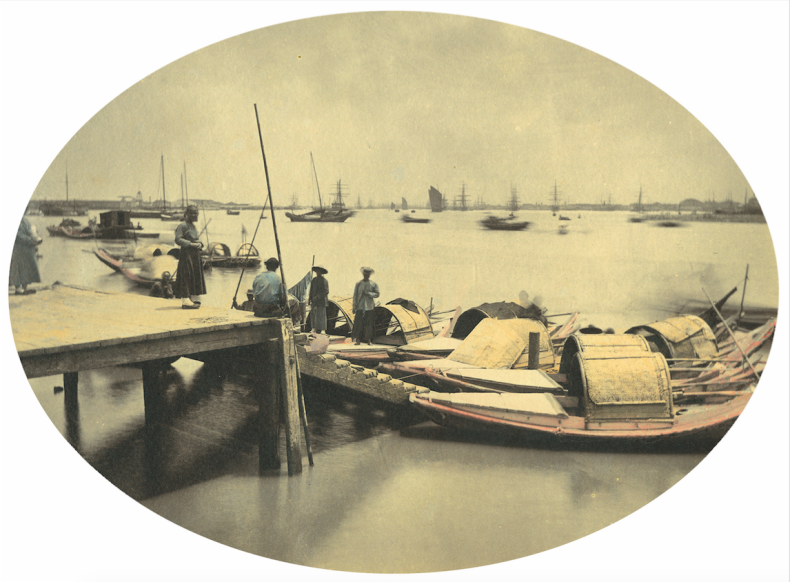Early photographers in China dragged their bulky box cameras, glass plates, and chemicals across continents and oceans in their pursuit of the vanishing vistas and changing cultures of China, and other faraway locations. Despite their heroic efforts, relatively few 19th-century photographs of China survive, and fewer still remain in China. This scarcity is the result of the cultural, political, and economic upheavals in the 20th century; the great photographs documenting 19th-century China are generally unavailable to the world’s scholars and lovers of Chinese culture, history, and art.
An exhibition this month at the China Exchange in London, ‘Life in Qing Dynasty Shanghai: The Photographs of William Saunders’ (4–12 November), arises from my 35-year-long quest to build a collection of historic photography from China. William Saunders’s work is a valuable resource for the study of China before industrialisation changed it forever. Saunders, who was born in Britain, moved to China in the 1850s and opened a photography studio in Shanghai in 1862. Although a handful of photographers had travelled through Shanghai before Saunders, none attempted to document the great commercial city so thoroughly, and none lived there for as long as he did. He was the first major photographer in China to make and sell hand-coloured paper prints, but until now there has never been a solo exhibition of his work.

Brush Seller, (c. 1870s), William Saunders. The Stephan Loewentheil Historical Photography of China Collection
In the days before the internet, collectors and dealers found their treasures in person at regional fairs and at book and photograph shops. No dealers specialised in Chinese photography. At the end of my visits to fairs or booksellers, I would ask weary dealers seeking to lighten their loads for their trips home (or to clear their shelves of seemingly unmarketable albums) if they had any photographic orphans from China.
By the mid 1990s, I had many early albums and thousands of important individual photographs, many of them unique. Few reference works were available, so I had to learn about many of the great photographers by studying the works themselves. Among the most important photographers active in 19th-century China were Europeans like Felice Beato, John Thomson, Thomas Child, and William Saunders – all masters of the art. Gradually I also learned about Chinese photographers who had participated in the ‘tourist’ photography trade: masters such as Lai Fong, Liang Shitai, Pun Lin, and Tung Hing. I was determined to obtain fine examples by each of them.
By the late 1990s, the nature of seeking early photographs had changed dramatically. The internet allowed me to analyse my collection in relation to great institutional holdings. Once I had identified gaps in the collection, I could then fill them by searching the burgeoning world of online auction houses. Previously hidden photographs were now universally available to those who could recognise what they saw.
I soon fixed my search upon missing masterworks created in China. Foremost among these was John Thomson’s series Foochow and the River Min (1873), which contains 80 fabulous carbon prints. Only a handful of copies of this album have survived, but I acquired the example that surfaced at Sotheby’s in New York in 2006. Other important acquisitions followed, such as two enormous collections of Beijing photographs by Thomas Child and an album of 80 photographs by Lai Fong in a fair in Hong Kong.
By 2012 I had found all but two of the key lacunae, but these proved elusive – until very recently. Felice Beato, the Anglo-Italian photographer who accompanied the expeditionary forces into Peking in 1860, created a series of large-format views of the city, which are a cornerstone of the field. Miraculously, a superb Beato album surfaced at a Pennsylvania antiques and household goods auction in 2014.

Shanghai Waterfront , (c. 1870s), William Saunders. The Stephan Loewentheil Historical Photography of China Collection
The final desideratum was William Saunders’ Portfolio of Sketches of Chinese Life and Character (1871). In 2012, I spotted a unique copy of Saunders’s great work at auction in Sweden. While all the known complete copies of the album had 50 images, this newly discovered copy in Sweden contained more than 70 photographs. Stacey Lambrow, my China photographic assistant, travelled to Sweden to make sure we secured the missing volume. By a remarkable coincidence, in subsequent months a fine group of hand-coloured Saunders prints was found at a book fair in New York. These fortuitous events led to the exhibition at the China Exchange. An important goal of this exhibition is to present the genius of Saunders as a photographer. The best of his photographs stand independently as art; his eye is acute, his technique is among the finest of the early photographers of China, and his hand-colouring is revolutionary.
My ultimate aim has been to create a comprehensive repository of the early photographic history of a great people and nation. Photographs have the power to transport us through time and space and they can also transcend the boundaries of language and culture to give us a unique view of an otherwise inaccessible world. I intend to stage a series of international exhibitions to bring the great photographers and photographs of China from this golden age, saved from the obscurity to which they were previously relegated, into public view.
‘Life in Qing Dynasty Shanghai: The Photographs of William Saunders’ is at China Exchange, London, from 4–12 November.
From the upcoming November issue of Apollo: subscribe here.

Why has it taken early Chinese photography so long to emerge from the shadows?
'Island Pagoda' from Foochow and the River Min The Stephan Loewentheil Historical Photography of China Collection
Share
Early photographers in China dragged their bulky box cameras, glass plates, and chemicals across continents and oceans in their pursuit of the vanishing vistas and changing cultures of China, and other faraway locations. Despite their heroic efforts, relatively few 19th-century photographs of China survive, and fewer still remain in China. This scarcity is the result of the cultural, political, and economic upheavals in the 20th century; the great photographs documenting 19th-century China are generally unavailable to the world’s scholars and lovers of Chinese culture, history, and art.
An exhibition this month at the China Exchange in London, ‘Life in Qing Dynasty Shanghai: The Photographs of William Saunders’ (4–12 November), arises from my 35-year-long quest to build a collection of historic photography from China. William Saunders’s work is a valuable resource for the study of China before industrialisation changed it forever. Saunders, who was born in Britain, moved to China in the 1850s and opened a photography studio in Shanghai in 1862. Although a handful of photographers had travelled through Shanghai before Saunders, none attempted to document the great commercial city so thoroughly, and none lived there for as long as he did. He was the first major photographer in China to make and sell hand-coloured paper prints, but until now there has never been a solo exhibition of his work.
Brush Seller, (c. 1870s), William Saunders. The Stephan Loewentheil Historical Photography of China Collection
In the days before the internet, collectors and dealers found their treasures in person at regional fairs and at book and photograph shops. No dealers specialised in Chinese photography. At the end of my visits to fairs or booksellers, I would ask weary dealers seeking to lighten their loads for their trips home (or to clear their shelves of seemingly unmarketable albums) if they had any photographic orphans from China.
By the mid 1990s, I had many early albums and thousands of important individual photographs, many of them unique. Few reference works were available, so I had to learn about many of the great photographers by studying the works themselves. Among the most important photographers active in 19th-century China were Europeans like Felice Beato, John Thomson, Thomas Child, and William Saunders – all masters of the art. Gradually I also learned about Chinese photographers who had participated in the ‘tourist’ photography trade: masters such as Lai Fong, Liang Shitai, Pun Lin, and Tung Hing. I was determined to obtain fine examples by each of them.
By the late 1990s, the nature of seeking early photographs had changed dramatically. The internet allowed me to analyse my collection in relation to great institutional holdings. Once I had identified gaps in the collection, I could then fill them by searching the burgeoning world of online auction houses. Previously hidden photographs were now universally available to those who could recognise what they saw.
I soon fixed my search upon missing masterworks created in China. Foremost among these was John Thomson’s series Foochow and the River Min (1873), which contains 80 fabulous carbon prints. Only a handful of copies of this album have survived, but I acquired the example that surfaced at Sotheby’s in New York in 2006. Other important acquisitions followed, such as two enormous collections of Beijing photographs by Thomas Child and an album of 80 photographs by Lai Fong in a fair in Hong Kong.
By 2012 I had found all but two of the key lacunae, but these proved elusive – until very recently. Felice Beato, the Anglo-Italian photographer who accompanied the expeditionary forces into Peking in 1860, created a series of large-format views of the city, which are a cornerstone of the field. Miraculously, a superb Beato album surfaced at a Pennsylvania antiques and household goods auction in 2014.
Shanghai Waterfront , (c. 1870s), William Saunders. The Stephan Loewentheil Historical Photography of China Collection
The final desideratum was William Saunders’ Portfolio of Sketches of Chinese Life and Character (1871). In 2012, I spotted a unique copy of Saunders’s great work at auction in Sweden. While all the known complete copies of the album had 50 images, this newly discovered copy in Sweden contained more than 70 photographs. Stacey Lambrow, my China photographic assistant, travelled to Sweden to make sure we secured the missing volume. By a remarkable coincidence, in subsequent months a fine group of hand-coloured Saunders prints was found at a book fair in New York. These fortuitous events led to the exhibition at the China Exchange. An important goal of this exhibition is to present the genius of Saunders as a photographer. The best of his photographs stand independently as art; his eye is acute, his technique is among the finest of the early photographers of China, and his hand-colouring is revolutionary.
My ultimate aim has been to create a comprehensive repository of the early photographic history of a great people and nation. Photographs have the power to transport us through time and space and they can also transcend the boundaries of language and culture to give us a unique view of an otherwise inaccessible world. I intend to stage a series of international exhibitions to bring the great photographers and photographs of China from this golden age, saved from the obscurity to which they were previously relegated, into public view.
‘Life in Qing Dynasty Shanghai: The Photographs of William Saunders’ is at China Exchange, London, from 4–12 November.
From the upcoming November issue of Apollo: subscribe here.
Share
Recommended for you
Not even Stalin could snuff out the legacy of early Soviet photography and film
The Jewish Museum’s exhibition reveals the importance of formal innovation to freedom of expression
How photography and painting focused the Victorian mind
An exhibition at Tate Britain makes forceful claims for the imaginative use of memory in both art and photography
One of the world’s oldest photography studios is closing down
The Bourne & Shepherd studio in Kolkata has a long history, but fire and the advent of the digital age have closed it down. Thankfully, its legacy lives on